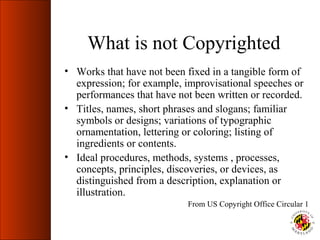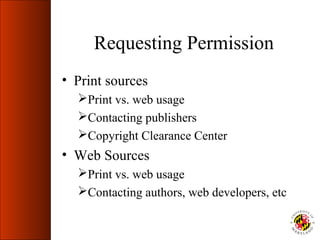Copyright and-intellectual-property-final
- 1. Copyright and Intellectual Property Issues Ellen Varley Distance Learning Specialist College of Agriculture and Natural Resources June 15, 2005 © 2005 Ellen N. Varley All Rights Reserved
- 2. Objectives • To determine difference between copyright and intellectual property • To identify ways to request permission to use copyrighted materials • To identify practical steps to protect your intellectual property • To access resources on copyright and intellectual property
- 3. Common Questions • Copyright and Fair Use Do you have the right to use other people’s material in your course? • Intellectual Property What happens to the intellectual material once you have posted it online? What can you do if material is used without authorization
- 4. What is Copyright? • "Copyright" is a protection that covers published and unpublished literary, scientific, and artistic works, whatever the form of expression, provided such works are fixed in a tangible or material form. • This means that if you can see it, hear it, and/or touch it-- it is protected. From Western University of Health Services http://www.westernu.edu/university/cr.xml
- 5. What is Copyrighted • Anything tangible – in a fixed form • Examples  Literary works, including software  Musical works, including accompanying words  Dramatic works, including accompanying music  Pantomimes and choreographic works  Pictorial, graphic and sculptural works  Motion pictures and other audiovisual works  Sound recordings  Architectural works From US Copyright Office Circular 1
- 6. What is not Copyrighted • Works that have not been fixed in a tangible form of expression; for example, improvisational speeches or performances that have not been written or recorded. • Titles, names, short phrases and slogans; familiar symbols or designs; variations of typographic ornamentation, lettering or coloring; listing of ingredients or contents. • Ideal procedures, methods, systems , processes, concepts, principles, discoveries, or devices, as distinguished from a description, explanation or illustration. From US Copyright Office Circular 1
- 7. Fair Use – The Four Factors • The purpose and character of the use, including whether such use is of commercial nature or is for nonprofit educational purposes • The nature of the copyrighted work • The amount and substantiality of the portion used in relation to the copyrighted work as a whole • The effect of the use upon the potential market for or value of the copyrighted work From Section 107 of Title XVII, U.S. Code
- 8. Copyright and the Internet • Everything on the Internet is copyrighted World Wide Web pages Courses Electronic mail, listservs and newsgroups • The same copyright laws apply to electronic materials as to print materials
- 9. What is Intellectual Property? • Intellectual Property Law, or IP, is composed of three primary fields: patents, copyrights, and trademarks. IP continues to expand as intellectual property claimants become even more sophisticated in protecting what they have created. Therefore, trade secrets, publicity, and even privacy notions are now used to protect intellectual creations. From William Mitchell College of Law http://www.wmitchell.edu/academics/areas/ip/whatisIP.html
- 10. Example of IP Policy – University of Texas System • Permits an author to own scholarly and educational works within field of expertise, unless the author was required to create the work. • If the University has an interest in scholarly or educational works, it should be set out in an agreement to avoid confusion and misunderstanding.
- 11. What you can do to protect IP • Password protect your site • Prominently display a copyright notice on your course – watermark • Use PDF files instead of HTML • Use streaming media
- 12. International Copyright Protection • Copyright protection rules are fairly similar worldwide, due to several international copyright treaties, the most important of which is the Berne Convention. Under this treaty, all member countries -- and there are more than 100, including virtually all industrialized nations -- must afford copyright protection to authors who are nationals of any member country. This protection must last for at least the life of the author plus 50 years, and must be automatic without the need for the author to take any legal steps to preserve the copyright.
- 13. International Copyright Protection • In addition to the Berne Convention, the GATT (General Agreement on Tariffs and Trade) treaty contains a number of provisions that affect copyright protection in signatory countries. Together, the Berne Copyright Convention and the GATT treaty allow U.S. authors to enforce their copyrights in most industrialized nations, and allow the nationals of those nations to enforce their copyrights in the U.S. From http://fairuse.stanford.edu
- 14. Requesting Permission • Print sources Print vs. web usage Contacting publishers Copyright Clearance Center • Web Sources Print vs. web usage Contacting authors, web developers, etc
- 15. CETUS – Excellent Resource • CETUS – the Consortium for Educational Technology in University Systems • Description of process and sample letter http://www.cetus.org/fair7.html
- 16. Permission to Publish • Ten Tips for Webmasters  http://www.nolo.com/article.cfm/ objectID /8CD796F2-9770-4ECA-B8F2B4F66DB17
- 17. Web Resources - Copyright • United States Copyright Office  http://www.loc.gov/copyright • Copyright Clearance Center  http://www.copyright.com/ • The Copyright Website  http://www.benedict.com/ • Copyright and Fair Use  http://fairuse.stanford.edu/
- 18. Web Resources - Copyright • Stanford University Library http://fairuse.stanford.edu/ Cyberspace Law Institute http://www.cli.org/ • 10 Myths about Copyright Explained  http://www.templetons.com/brad/copymyths.html
- 19. Web Resources – Intellectual Property • University of Texas System  http://www.utsystem.edu/ogc/intellectualproperty/distance.htm • University of Wisconsin  http://www.uwex.edu/disted/intprop.html • William Mitchell College of Law  http://www.wmitchell.edu/academics/areas/ip/whatisIP.html
- 20. References • Websites listed • Teaching Online: A Practical Guide by Susan Ko and Steve Rossen, 2001





















